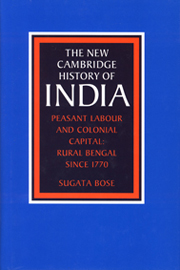3 - Property and production
Published online by Cambridge University Press: 28 March 2008
Summary
Historians of colonial India have been puzzled lately by the mismatch between the rapid expansion of commodity production for a capitalist world market on the one hand, and low levels of productive investment in agriculture and an apparent continuity in non-capitalist agrarian social structures on the other. The sense of bewilderment is itself a scholarly advance from ‘traditions’ set in the later nineteenth century which saw markets, agricultural investment and agrarian relations as themes fit for separate enquiry. Needless to say, this led to ‘debates’ about the economic results of colonialism marked by a peculiar absence of dialogue. Yet even the more perceptive scholars have continued to harbour teleological assumptions about capitalist transformation. This has led some to declare that the ‘ultimate’ dominance of capitalism denotes, willy-nilly, some form of capitalist mode of production in agriculture. Others, convinced that what they see in the rural areas is a ‘semi-feudal’ or simply a ‘peasant’ mode of production, have been concerned with identifying the ‘obstacles’ or ‘impediments’ in the way of capitalism bearing full sway. Consequently, the much-needed probe into the analytics of the relationship between capitalist ‘development’ under colonialism and agrarian continuity or change has been almost always slightly off the mark.
Arguments about continuity in agrarian relations during colonial rule have rested generally, if not purely, on descriptive rather than analytical categories. It has been found acceptable to compare, for instance, levels of peasant differentiation or landlessness at the beginning and at the end of the colonial era. The descriptive approach has tended to obscure subtle but very real processes of change.
Keywords
- Type
- Chapter
- Information
- Peasant Labour and Colonial CapitalRural Bengal since 1770, pp. 66 - 111Publisher: Cambridge University PressPrint publication year: 1993
References
- 2
- Cited by



